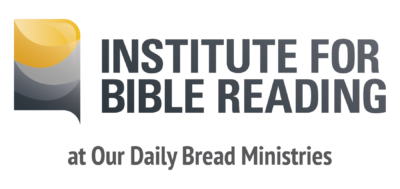Introducing the Institute for Bible Reading
Welcome to our website! We hope this will be a great resource for you, and we are looking forward to sharing our perspective on good Bible reading. But why did we form the Institute for Bible Reading in the first place?
Many of us remember the famous scene in The Matrix when Neo meets Morpheus for the first time. Morpheus addresses the idea that’s been bothering Neo: that the world he lives in, the world he’s known his entire life, is not what it seems—that there’s a deeper truth hiding behind the curtain that’s been pulled over his eyes.
The Institute’s story is not nearly as dramatic as Neo’s, but at some point in each of our lives we were confronted with the fact that there’s more to the Bible than we thought. Not only that, but we were also confronted with the brutal truth that the way the Bible is used today isn’t working. So we decided to take the red pill and start digging.
We started by looking at the Bible itself and researching how we got our modern Bible format. We discovered that much of what makes up our modern Bible—chapters, verses, section heads, notes, commentary, cross-references, and red letters—has only been around for a few hundred years. The Bible used to be formatted like any other book. Now it looks more like an encyclopedia. Could the format influence how we read it?
You bet. As we analyzed the most common practices surrounding the Bible, three troubling habits emerged:
• First, we read the Bible in tiny fragments. Rather than read the Bible book by book, we typically proceed verse by verse or chapter by chapter. Many times we jump around to a different part of the Bible before we get a chance to finish the author’s thought.
• Second, we read out of context. Understanding the author’s intended message for his original audience, understanding a book’s place in the grand narrative of the Bible, and understanding the type of literature it is are all critical to good Bible reading.
• Third, we read in isolation. Reading alone is a relatively new phenomenon, since most people didn’t have their own personal Bible until the printing press was invented. For 1500 years (much longer if you count the Hebrew Scriptures), people gathered together and primarily heard the text and wrestled over its interpretation together. Today most Bible reading is done alone, and many group Bible studies are done topically, jumping around within the Bible rather than reading and discussing whole books.
We believe that the modern Bible format and unhealthy Bible practices are a big part of why so many people are struggling to read the Bible today. Who can blame them? There’s so much more to the Bible than what people are being given. It’s only natural to assume that they’re going to be frustrated to the point of giving up.
The statistics on Bible reading show us that even though there’s better access to the Bible than ever before, Bible reading and Bible engagement are in a freefall. Millennials are only half as likely to read the Bible as older generations (ABS/Barna). Only 1 in 5 people say their church helps them connect deeply with the Bible (REVEAL). The message is clear: despite the exciting advances in Bible translation and distribution, simply owning a Bible isn’t enough. People need help actually reading, understanding, and living it.
We formed the Institute for Bible Reading to address this issue. God has given us the story of his plan of redemption for his creation and people need help seeing it, understanding it, and finding their place within it. The Bible still has life-changing power, we just need to start honoring it as the book God gave us.


